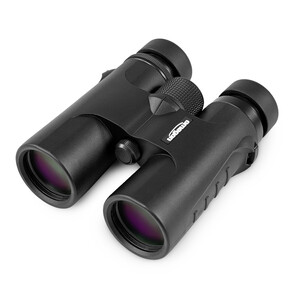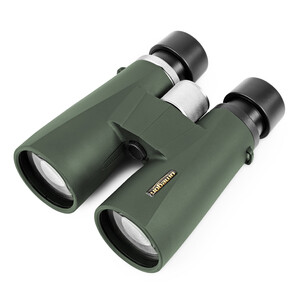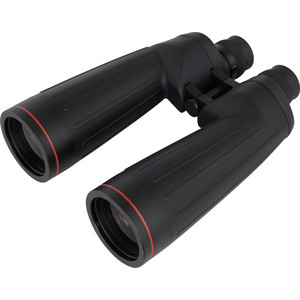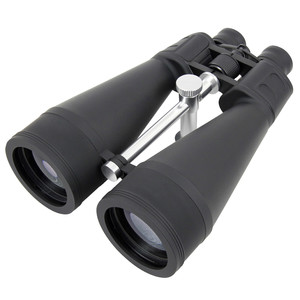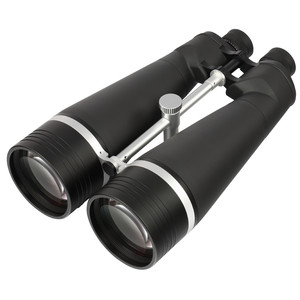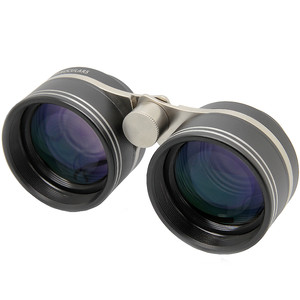Astronomy with binoculars
Telescope or binoculars? Why not use both! Some targets are actually more fun with binoculars. And they’re always the quicker option.
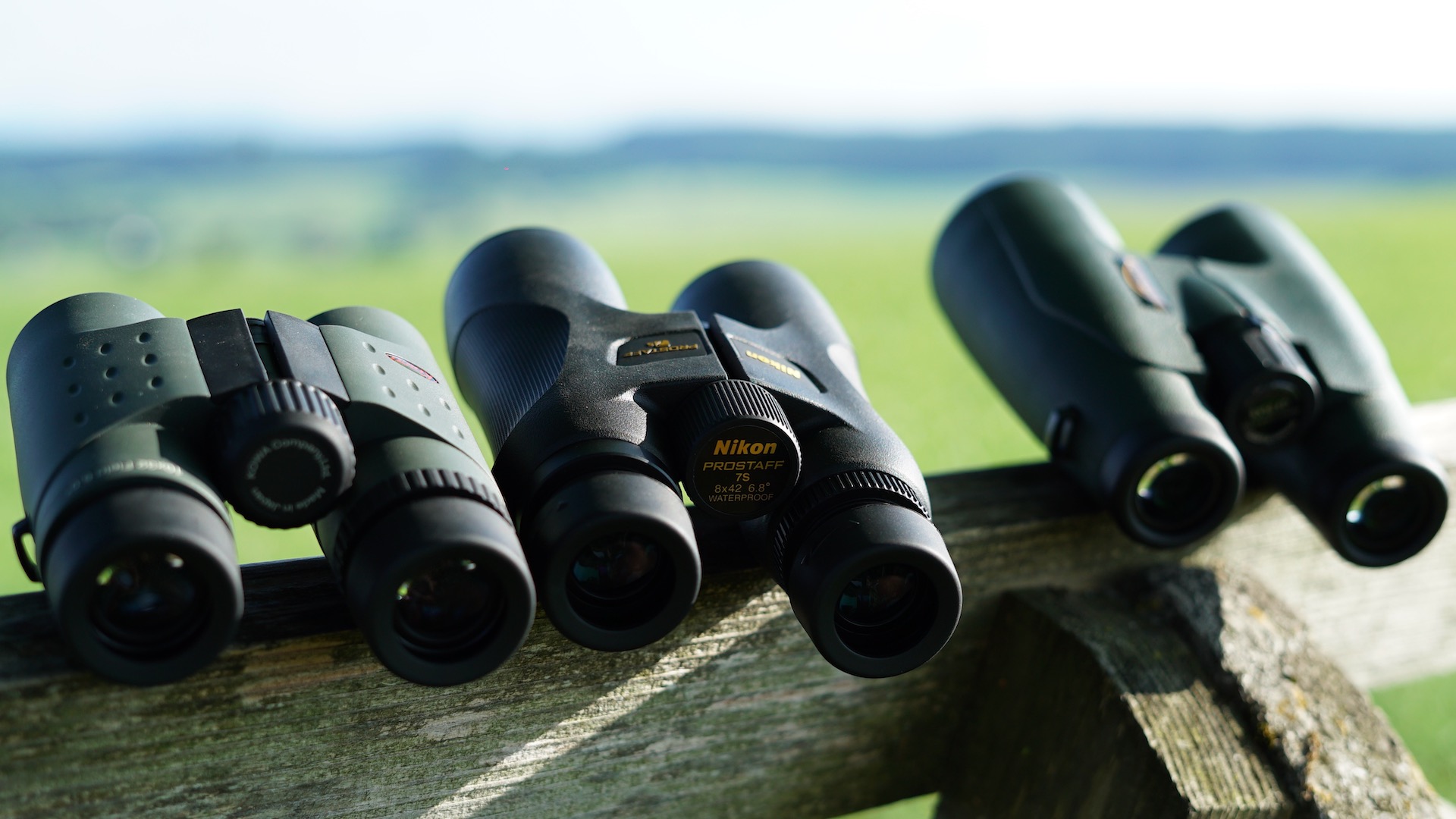
Jacket on, binoculars in the hand, you’re ready to go out and take a look at the stars. Time taken: two minutes. If you try this with a telescope, time taken: more like 30 minutes. Minimum. Binoculars will always save you time, allowing you to use every moment for astronomy. How does that sound?
Binoculars are often overlooked as an astronomical instrument. But they can offer wonderful observing experiences, whether you use them for that gap in the clouds seen from your front garden, or for a night observing from a summit in the foothills of the Alps.
In this article you will learn:
- Why binoculars are an excellent complement to your telescope
- What are especially good observing targets
- Which binoculars are particularly suitable for astronomy
- Practical recommendations for all-round astronomy binoculars
- Which binoculars can (almost) replace a telescope
4 reasons why binoculars can sometimes be the better choice
Telescopes and binoculars each have their own strengths and weaknesses. Neither of these two can replace the other. But they complement one another brilliantly!
1 The telescope in your jacket pocket
Unlike a telescope, binoculars are small and fit in your luggage. This is an advantage when you travel: you may not always want to fill your entire boot with astronomical equipment.
2 Better overview of the sky
Offering a 5-6° field of view, with binoculars you can relax and observe even large celestial objects in the context of their surroundings. With a telescope, even if you use a 2"-eyepiece, all you will manage is 2° – less than half of the field of view of the binoculars! So star clusters like Pleiades and Hyades are targets that you can only enjoy in their entirety with binoculars.
3 Orientation without headstands
Especially when setting out on your astronomy journey, it is easy to forget that you will see an upside-down or laterally reversed image through the eyepiece. This can cause confusion when looking for targets using a star chart for reference. Binoculars show the sky upright and right-sided, which helps with orientation – a faithful companion for a night of observation from your favourite location.
4 Two eyes are better than one
Using both eyes to observe is wonderfully relaxing. It is not necessary to close or cover one eye, the image you see is natural and plastic. Details are easier to make out because one eye can compensate for any image defects in the other eye and, overall, better visual acuity and higher resolution is the result.
Where do binoculars reach their limits? No details are visible on planets, here the image is far too small. Planets or craters on the surface of the Moon are the domain of telescopes. Here you need a lot of magnification to see details. And in the case of faint deep sky objects, which depend on a large aperture’s light gathering capability, the telescope also has the advantage. But bright deep sky objects can look really amazing through binoculars!
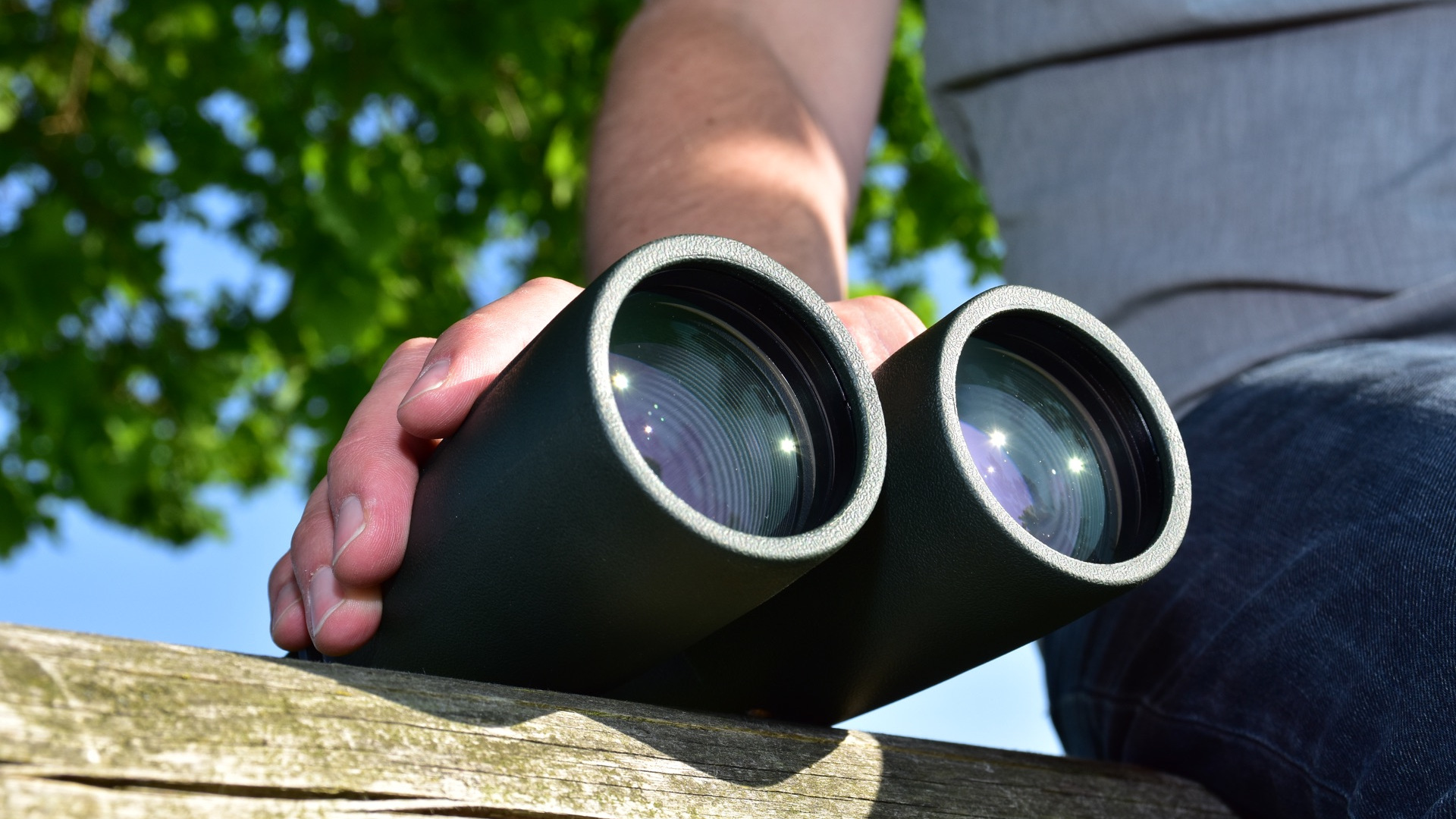 A faithful companion for a night of observation from your favourite location
A faithful companion for a night of observation from your favourite location These targets are waiting for you
There are more than a hundred targets in the night sky that you can observe with binoculars. Open star clusters, bright nebulae and some galaxies are wonderful targets. Roaming across the Milky Way with binoculars on a warm summer night is one of the most wonderful experiences you can imagine. There are also many double stars visible through binoculars. A tripod helps stabilise the image and separate the two components.
Wherever you do not need large magnification or a large aperture, it is worth trying binoculars first. You need a few helpful examples?
Pleiades with wow effect
The bright Pleiades star cluster is clearly visible to the naked eye and a magnificent sight through binoculars with 10 times magnification. Dozens of glittering stars, framed by the tender blue of the bright main stars. If you want to inspire someone with astronomy, show them Pleiades through binoculars. There is hardly any other target with such a "wow" effect.
The celestial manger
The M44 star cluster is around 610 light years away, has the beautiful-sounding name Praesepe, Latin for “manger”, and is also known as the Beehive Cluster. It is in fact the second-brightest star cluster after Pleiades, and is closest to Earth. You can see Praesepe with the naked eye from dark sky locations, but it is only through binoculars that the cluster dissolves into single stars.
Double star Mizar and Alcor
The best-known double star in the night sky can be found in the constellation Ursa Major. Look at the star in the middle of the plough-handle and you will see its companion called Alcor, which can be easily distinguished with binoculars. With 20x80 binoculars you will discover a surprise: Mizar is itself a double star. If you use a tripod, you will be able to make out the second component.
Regulus in Leo
Regulus, the main star in constellation Leo, is somewhat more demanding. But did you know it’s a double star? You can observe it with your binoculars. Regulus, a blue-white star with a surface temperature of 12,000 Kelvin, is around 3.5 times larger than the Sun. The ball of gas, which is 77 light years away, rotates around its own axis in just 15 hours, which causes it to be highly oblate. At a distance of 175″, we find a magnitude 8, orange companion that can be seen with a 10Χ50 binoculars.
You can find more observation targets here:
Astronomy with binoculars: the 10 most beautiful objects in the spring sky
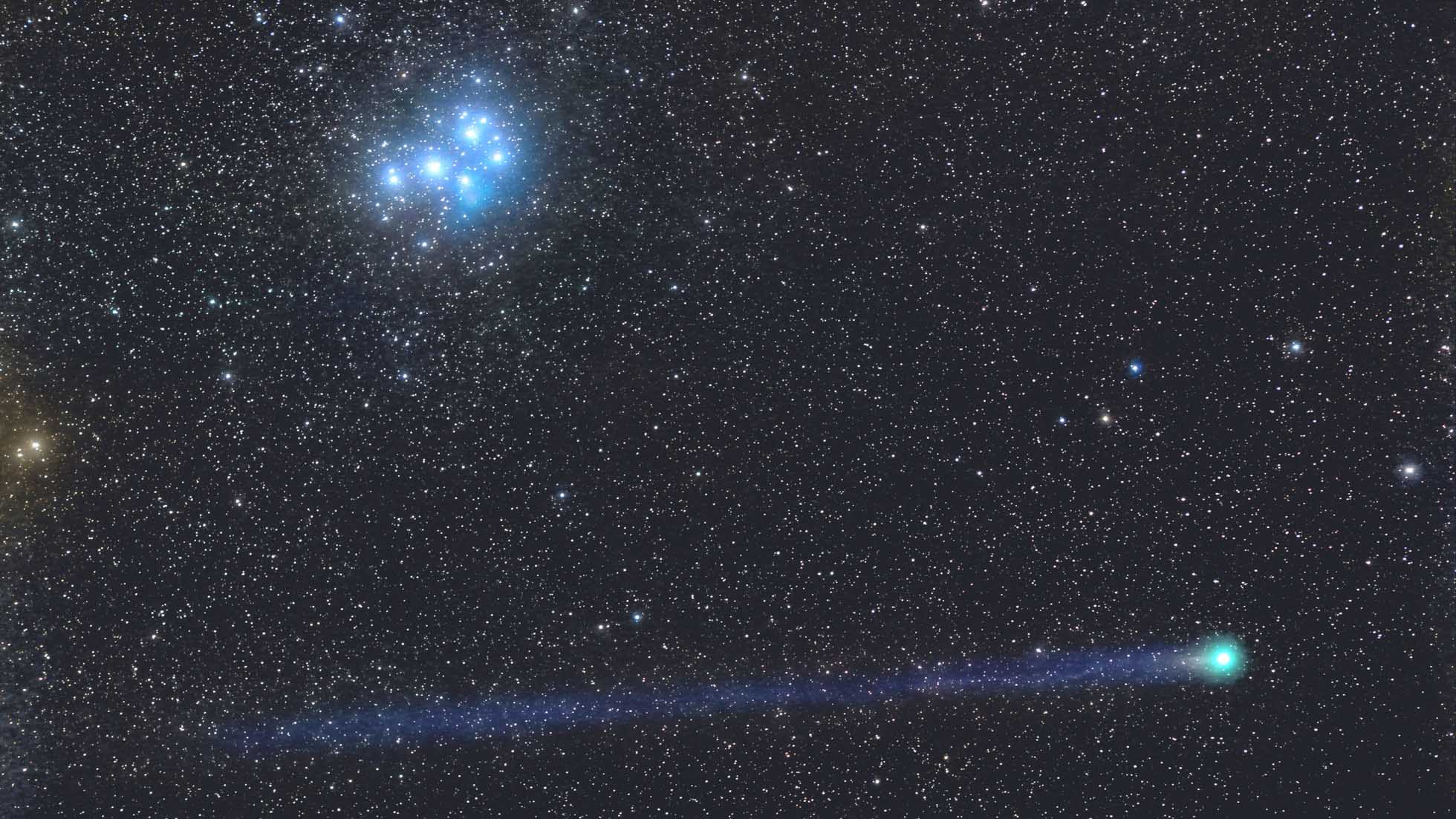 Comet Lovejoy visits Pleiades. Photo: Cristian Fattinanzi
Comet Lovejoy visits Pleiades. Photo: Cristian FattinanziWhich binoculars are suitable for astronomy – and why
A pair of binoculars is somewhere to be found in many households. If you already have a pair, this is a good starting point. You can get going tonight with them, and you'll see more than with the naked eye alone!
Nevertheless, not all binoculars are equally suitable for observing the night sky, of course. What qualities make binoculars suitable for astronomy?
Only for dark skies: the classic 7x50
Classic 7x50 Porro prism binoculars enjoy widespread use. Binoculars of this construction are bulky and not always lightweight, but they are good for hand-held use, and the smaller magnification ensures a steady image. For astronomy, however, these binoculars are of only limited suitability, because they require a really dark sky. Why is that?
Larger aperture: collecting light for a brighter image
The perfect astronomy binoculars are a compromise between conflicting requirements. First of all, there is the aperture, i.e. the diameter of the front lenses. For binoculars, this is the second number: 50 mm in the case of our 7x50 binoculars. A larger aperture means more light collection, you see more stars and fainter objects. Well, that sounds pretty good. What’s the catch?
Light must find its way into the eye
The exit pupil also grows as the diameter of the front lens increases. This is the small disc of light that you can see in the eyepiece when you point the binoculars at a uniformly bright surface, such as a cloudy sky. This exit pupil should not be larger than the aperture of your eye, otherwise your pupil will block part of the escaping light bundle and as a result, you will not be making full use of the binoculars’ aperture. Who wants to drag 50 mm binoculars around, and then only use 40 mm to observe? The second effect of large exit pupils is even more annoying: the sky is brightened, faint stars and nebulae disappear. For this reason, our 7x50 with its 7 mm exit pupil already demands a really good Alpine sky.
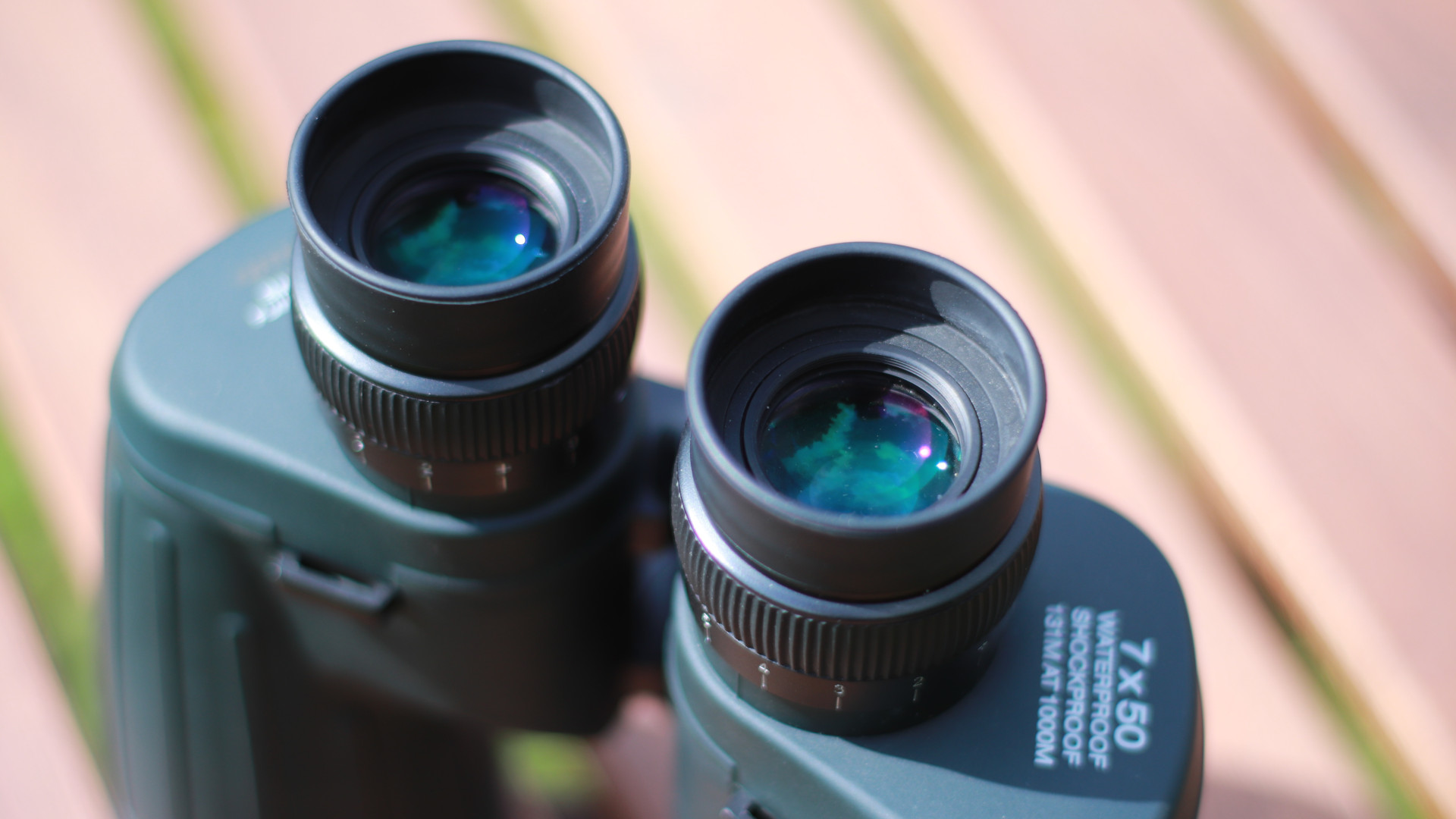 Only for dark skies: the classic 7x50
Only for dark skies: the classic 7x50The perfect all-rounder astronomy binoculars
The mix of aperture and magnification is what matters
Can you make the exit pupil smaller? Yes, with more magnification, the first number on the binoculars. With 10x50 binoculars, i.e. a magnification of 10x, the size of the exit pupil is reduced to a more usable 5mm. This makes sense for another reason: the human eye's pupil aperture is limited and decreases continuously with age. For most people, the exit pupil should therefore not exceed 5 mm.
High magnification only with tripod
A magnification of 10x can still be hand-held, but it is not as easy to hold the binoculars as still as with 7x magnification, since the slightest trembling of the hand will lead to a shaky image. More than 10x is generally not possible for hand-held use for most observers, the gain in detail will be rendered unusable by the difficulty in holding the image steady. An adapter with which you can attach the binoculars to a photographic tripod will help here.
How to calculate the field of view
All binoculars have a certain field of view, which is determined by the optical design. The larger the field of view, the more sky you will see in the eyepiece. The field of view is given in metres at a distance of one thousand metres, for example,a 124 m field of view at a distance of 1,000 metres. In telescopes, this angle, the field of view, is given in degrees. This is a more useful measure with respect to the sky. The conversion is no problem: simply divide the field of view in metres at 1,000 metres by a factor of 17.5, since 1° corresponds to 17.5 metres in a distance of 1,000 metres. In our example, the binoculars with a 124 m field of view at a distance of 1,000 m will have a visible sky area of about 7°, an excellent value!
Other features that distinguish good binoculars
In addition to the field of view, there are other important quality criteria that distinguish good from average binoculars. Light transmission, colour errors and sharpness at the image edge all have a big impact on your observing enjoyment – and on what you can actually see through the eyepiece. Knowledge of these criteria will allow you to quickly find the right binoculars!
More on the optical quality of binoculars in our binocular knowledge
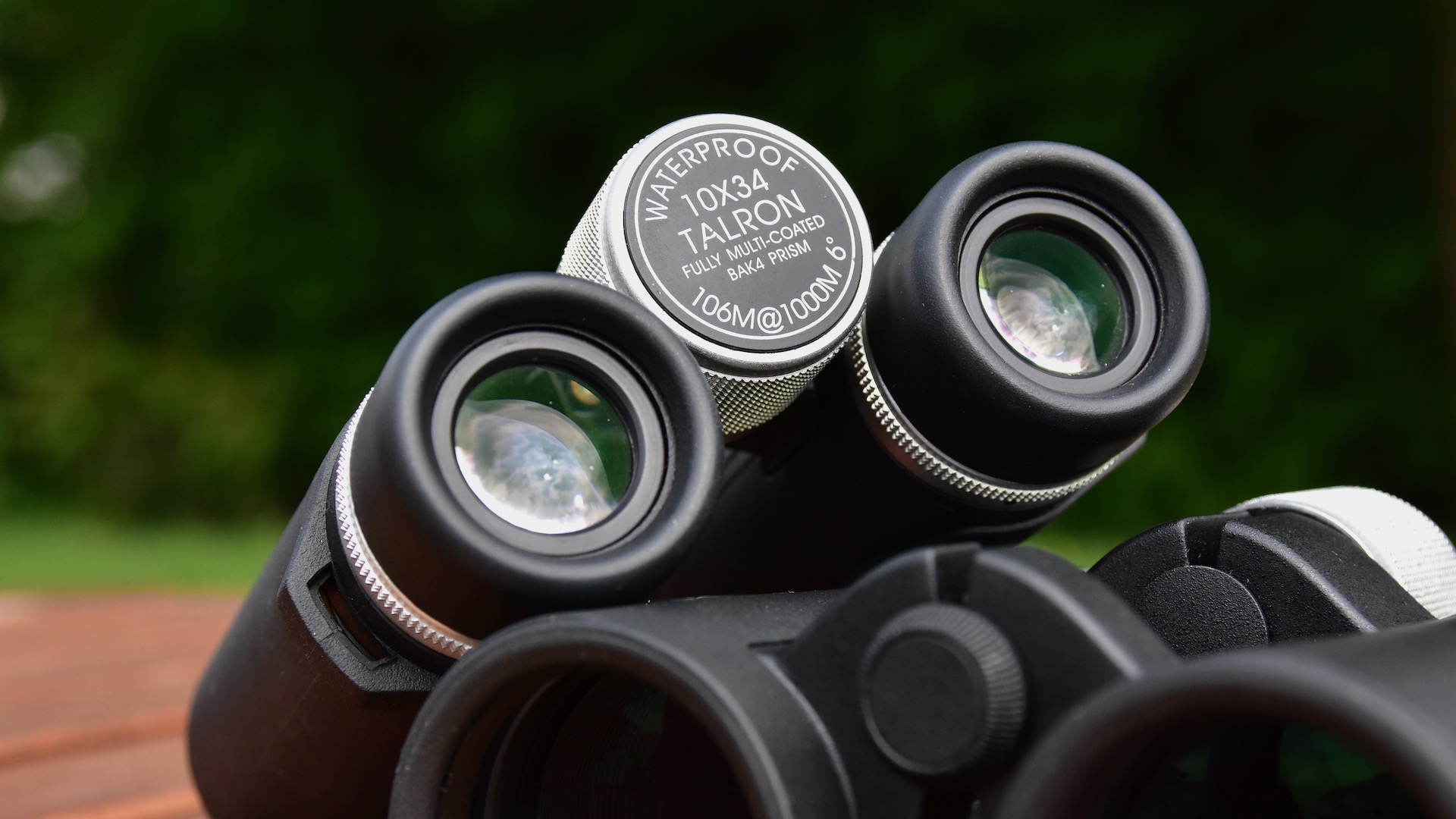 Everything in sight with a 6° field of view
Everything in sight with a 6° field of view 3 binoculars for the most fantastic astronomy evenings
In addition to the features above, we can give you some very specific recommendations to help you on your way. Decide whether you want to have all-purpose binoculars with good astronomy capabilities, or binoculars that are clearly oriented toward astronomy – in this case you should also plan for a tripod adapter and a photographic tripod.
42 mm roof prism binoculars: the all-purpose astronomy binoculars
With 8x42 roof prism binoculars, you have great all-purpose astronomy binoculars that are compact, easy to transport and hold, and because of their moderate magnification are not susceptible to image-shake. The 5 mm exit pupil remains within a workable range that is also suitable for use under a light-polluted suburban sky. These are our top tip if you also want to use the binoculars for nature-watching.
Thanks to its roof prism construction, the binoculars are so compact and lightweight that you can go for magnifications of up to 10x. You should ideally test before you buy, to be certain that you can keep the binoculars steady at this magnification. The exit pupil drops to about 4 mm. You can see more details, e.g. on the Moon.
The 8x56 is a specialist for dark skies, it collects almost twice as much light as the 8x42. The exit pupil increases to 7 mm.
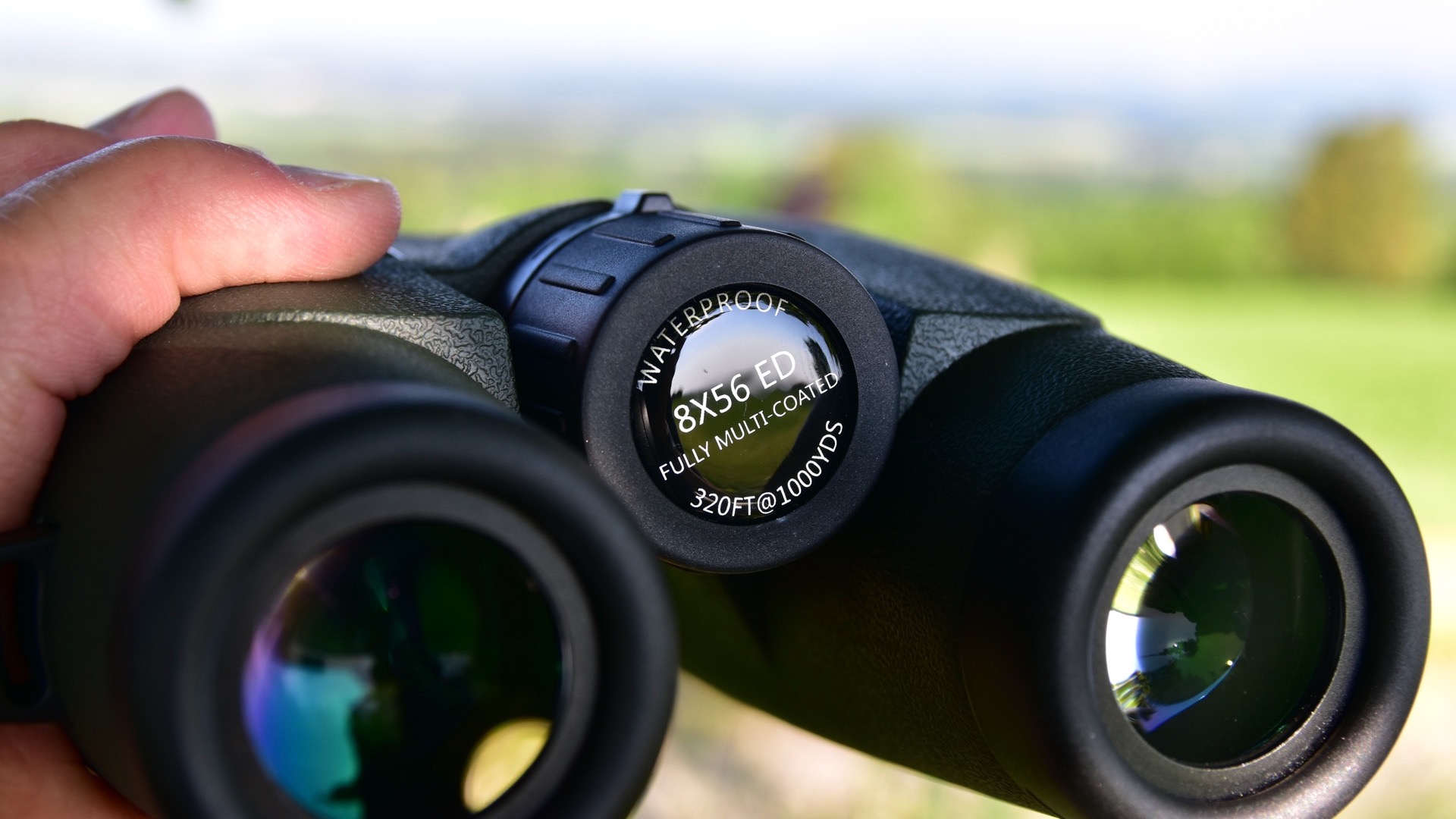 Specialist for a dark sky: Omegon Hunter 8x56 with ED-elements
Specialist for a dark sky: Omegon Hunter 8x56 with ED-elements50 mm Porro prism binoculars: the top choice for astronomy
10x50 Porro binoculars are really the top choice for astronomy. Due to their higher magnification and weight, they are not as easy to hold steady as an 8x42 roof prism model. But resting on a tripod or other surface, they show a lot of details in star clusters such as Pleiades or Praesepe. With a 5 mm exit pupil, even suburban skies are no problem.
12x50 Porro binoculars will show you more detail, but you’ll find that hand-held observing is barely possible. The exit pupil drops to about 4 mm, resolution and richness of detail are tremendous. Make sure you put a tripod adapter and a tripod in your bag, otherwise image-shake will spoil your fun.
A further increase in resolution is provided by large astronomical binoculars. Here, you always observe with a tripod; some binoculars have 45° or 90° angled eyepieces and are also suitable for observing near the zenith.
Large binoculars: the ultimate binoculars for astronomy
Binoculars with an aperture of 70 mm or more will collect a huge amount of light. 70 mm binoculars collect almost twice as much light as those with a 50 mm aperture. The large aperture has another advantage: a higher resolution capability. This helps, for example, when observing double stars.
Large binoculars magnify significantly more than all-purpose binoculars. Magnifications of 15x or 20x are common and help to keep the exit pupil in check. Large 15x70 binoculars have an exit pupil of 4.6 mm, not much larger than a 10x42 all-rounder with 4.2 mm. This means that these binoculars can also be used under a light-polluted sky.
High-magnification binoculars should be used with a tripod, in order to be able to really appreciate the richness of detail and not to lose detail through a shaking image. An adapter is built into most large binoculars or can be retrofitted; a photographic tripod is sufficient for the lighter models. For the heavier large binoculars, we recommend a stable tripod with a video tilt head or, even better, with a fork mount.
Large 70-80 mm binoculars in our shop
Help with targets near the zenith: the angled eyepiece for amateur astronomers
With a pair of all-purpose or compact binoculars, a tripod adapter and photographic tripod, you are well-equipped for a night sky safari. The image is still and crisp, a sheer joy. At least as long as your targets aren't too high in the sky. Because you quickly come to realise: looking up towards the zenith with binoculars is anything other than comfortable. A comfortable posture is just as important for observing as good optics. If you are more relaxed when you observe, you will see more.
The solution to this problem are binoculars with 45° or 90° angled eyepieces. Such large binoculars, which offer sensitive tracking from a stable fork mount together with a heavy tripod, are the premier class for relaxed two-eyed observation. The sky from horizon to zenith is available to you. Magnifications from 20x to 40x will reveal a world full of detail. However, these instruments will not fit in your jacket pocket, and are comparable to a telescope in terms of transportation requirements and price. It is no surprise that for some observers, these large binoculars can even replace a telescope!
Checklist: you should pay attention to these 7 points
Are you ready to commence the enjoyment of astronomy through binoculars? With our checklist, you will be on the safe side when choosing your binoculars:
- Aperture: for observing hand-held 42 to 50 mm, with a photographic tripod 70 to 80 mm, with a stable fork mount up to 100 mm
- Magnification: for observing hand-held 8x to 10x, higher magnifications with tripod, for large binoculars up to 40x
- Exit pupil 4 to 5 mm, for dark Alpine skies up to 7 mm *
- Largest possible field of view (ideally 6° or more) **
- High-quality lens and prism coating for maximum light transmission
- Thread for a tripod adapter
- 45° or better still 90° angled eyepieces for relaxed observing with large binoculars
* Exit pupil = aperture/magnification, for a 10x50 this is therefore 5 mm
** Divide the number of metres at 1,000 meters by 17.5 to get the field of view in °
Starry skies to-go
As astronomy fans, we would love to focus on nothing else. But this doesn't always have to mean a whole night of observing - even a quick look at the evening sky is enough to keep our passion alive. Here, good binoculars are a great complement to your telescope. Quick to hand, no set-up required, great field of view, with an upright and right-sided image. In short, starry skies to-go!
Binocular tours of the sky for all seasons
Not sure which binoculars are the right ones for you? Ask our consultants - they are active binocular observers and are happy to help you!

